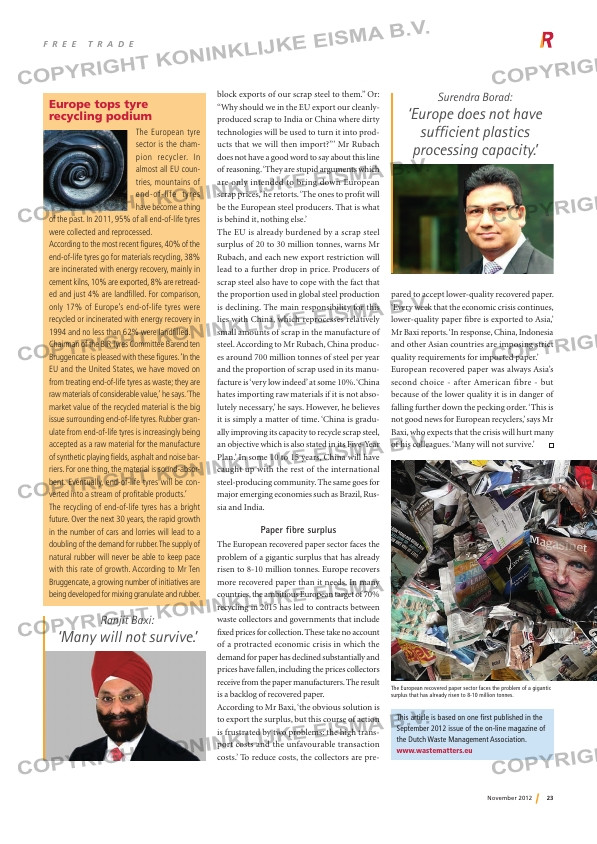Page 23 from: November 2012

23November 2012
F r e e t r a d e
This article is based on one first published in the
September 2012 issue of the on-line magazine of
the Dutch Waste Management Association.
www.wastematters.eu
Europe tops tyre
recycling podium
The European tyre
sector is the cham-
pion recycler. In
almost all EU coun-
tries, mountains of
end-of-l ife tyres
have become a thing
of the past. In 2011, 95% of all end-of-life tyres
were collected and reprocessed.
According to the most recent figures, 40% of the
end-of-life tyres go for materials recycling, 38%
are incinerated with energy recovery, mainly in
cement kilns, 10% are exported, 8% are retread-
ed and just 4% are landfilled. For comparison,
only 17% of Europe’s end-of-life tyres were
recycled or incinerated with energy recovery in
1994 and no less than 62% were landfilled.
Chairman of the BIR Tyres Committee Barend ten
Bruggencate is pleased with these figures. ‘In the
EU and the United States, we have moved on
from treating end-of-life tyres as waste; they are
raw materials of considerable value,’ he says. ‘The
market value of the recycled material is the big
issue surrounding end-of-life tyres. Rubber gran-
ulate from end-of-life tyres is increasingly being
accepted as a raw material for the manufacture
of synthetic playing fields, asphalt and noise bar-
riers. For one thing, the material is sound-absor-
bent. Eventually, end-of-life tyres will be con-
verted into a stream of profitable products.’
The recycling of end-of-life tyres has a bright
future. Over the next 30 years, the rapid growth
in the number of cars and lorries will lead to a
doubling of the demand for rubber. The supply of
natural rubber will never be able to keep pace
with this rate of growth. According to Mr Ten
Bruggencate, a growing number of initiatives are
being developed for mixing granulate and rubber.
Surendra Borad:
‘Europe does not have
sufficient plastics
processing capacity.’
block exports of our scrap steel to them.” Or:
“Why should we in the EU export our cleanly-
produced scrap to India or China where dirty
technologies will be used to turn it into prod-
ucts that we will then import?”’ Mr Rubach
does not have a good word to say about this line
of reasoning. ‘They are stupid arguments which
are only intended to bring down European
scrap prices,’ he retorts. ‘The ones to profit will
be the European steel producers. That is what
is behind it, nothing else.’
The EU is already burdened by a scrap steel
surplus of 20 to 30 million tonnes, warns Mr
Rubach, and each new export restriction will
lead to a further drop in price. Producers of
scrap steel also have to cope with the fact that
the proportion used in global steel production
is declining. The main responsibility for this
lies with China, which reprocesses relatively
small amounts of scrap in the manufacture of
steel. According to Mr Rubach, China produc-
es around 700 million tonnes of steel per year
and the proportion of scrap used in its manu-
facture is ‘very low indeed’ at some 10%. ‘China
hates importing raw materials if it is not abso-
lutely necessary,’ he says. However, he believes
it is simply a matter of time. ‘China is gradu-
ally improving its capacity to recycle scrap steel,
an objective which is also stated in its Five-Year
Plan.’ In some 10 to 15 years, China will have
caught up with the rest of the international
steel-producing community. The same goes for
major emerging economies such as Brazil, Rus-
sia and India.
Paper fibre surplus
The European recovered paper sector faces the
problem of a gigantic surplus that has already
risen to 8-10 million tonnes. Europe recovers
more recovered paper than it needs. In many
countries, the ambitious European target of 70%
recycling in 2015 has led to contracts between
waste collectors and governments that include
fixed prices for collection. These take no account
of a protracted economic crisis in which the
demand for paper has declined substantially and
prices have fallen, including the prices collectors
receive from the paper manufacturers. The result
is a backlog of recovered paper.
According to Mr Baxi, ‘the obvious solution is
to export the surplus, but this course of action
is frustrated by two problems: the high trans-
port costs and the unfavourable transaction
costs.’ To reduce costs, the collectors are pre-
Ranjit Baxi:
‘Many will not survive.’
pared to accept lower-quality recovered paper.
‘Every week that the economic crisis continues,
lower-quality paper fibre is exported to Asia,’
Mr Baxi reports. ‘In response, China, Indonesia
and other Asian countries are imposing strict
quality requirements for imported paper.’
European recovered paper was always Asia’s
second choice – after American fibre – but
because of the lower quality it is in danger of
falling further down the pecking order. ‘This is
not good news for European recyclers,’ says Mr
Baxi, who expects that the crisis will hurt many
of his colleagues. ‘Many will not survive.’
The European recovered paper sector faces the problem of a gigantic
surplus that has already risen to 8-10 million tonnes.
RI_9-FreeTrade.indd 23 09-11-12 09:32



